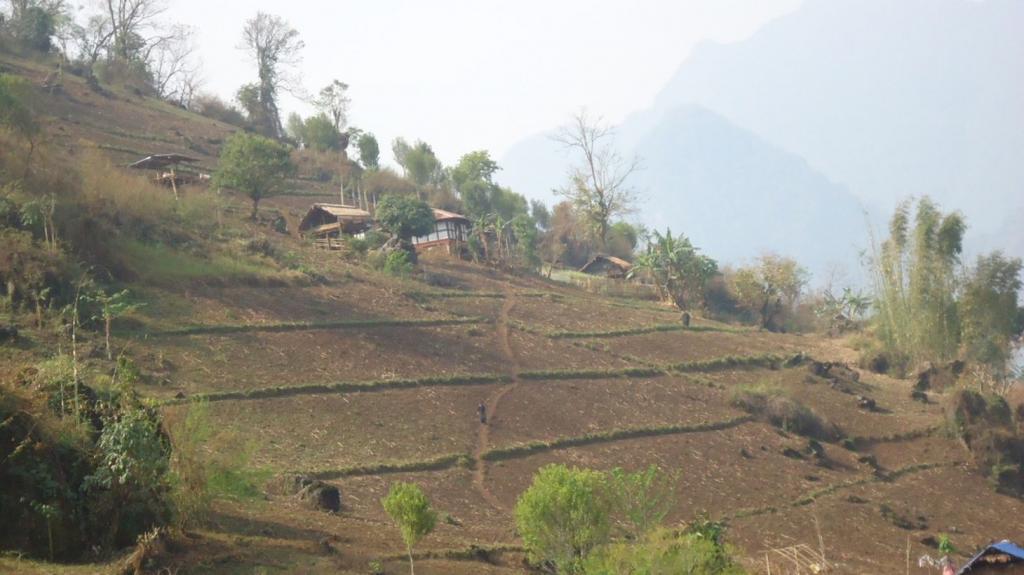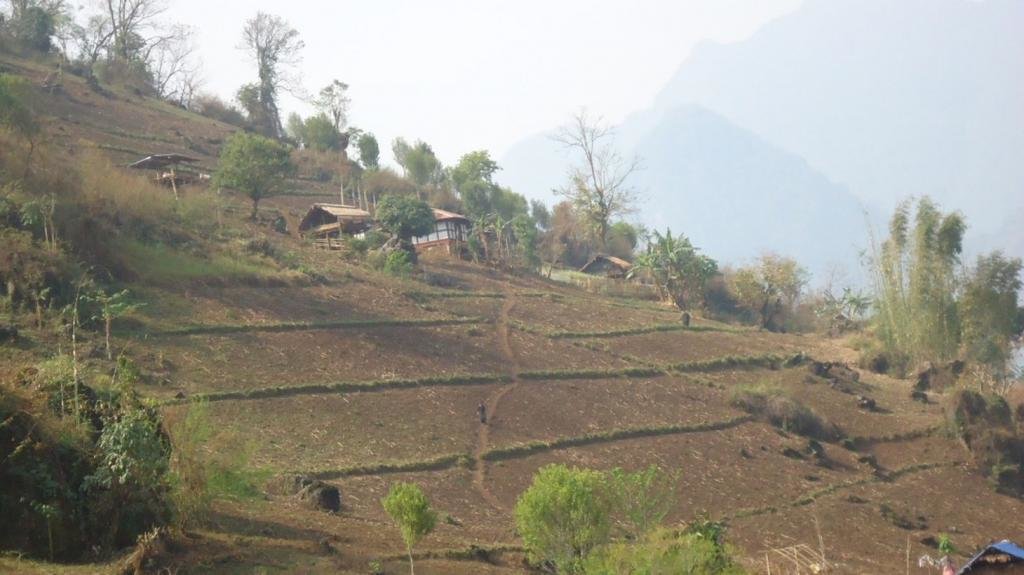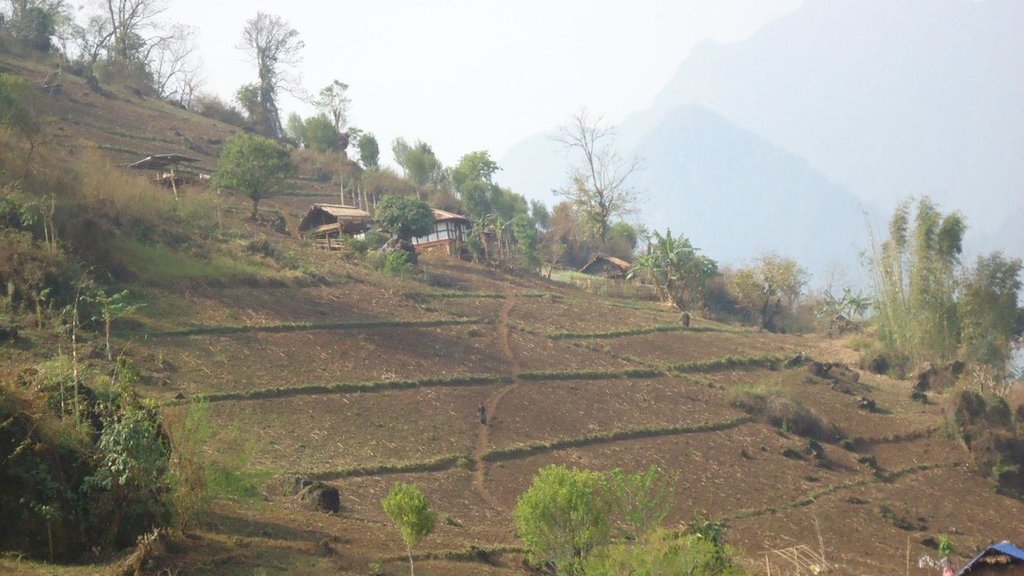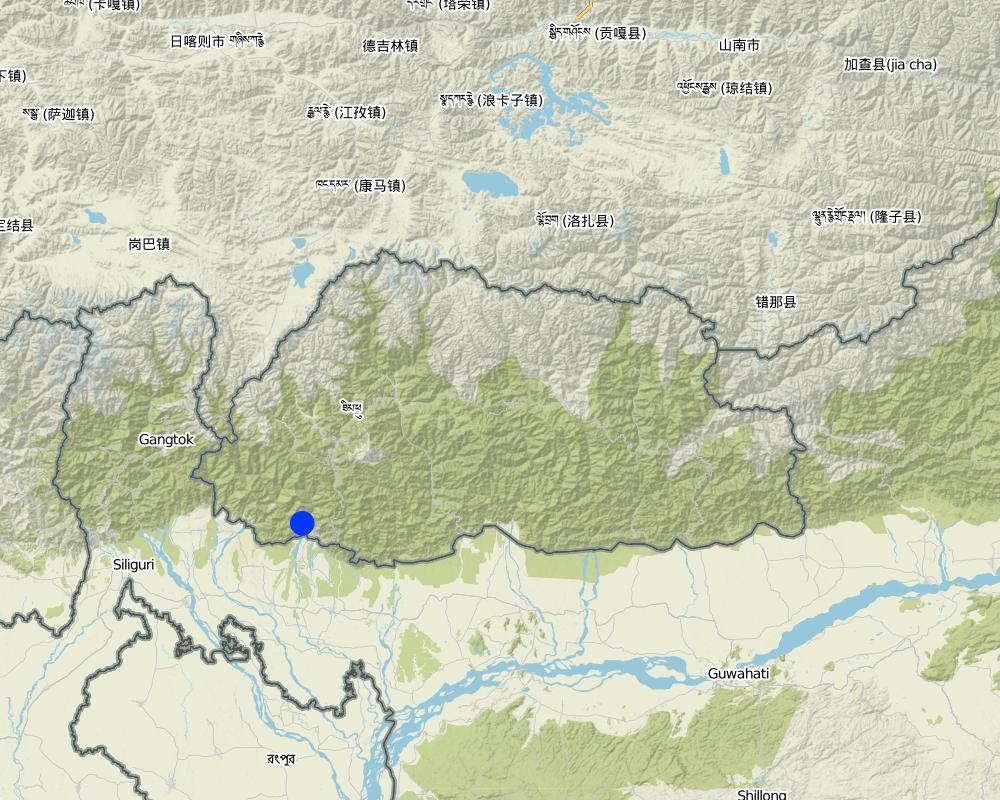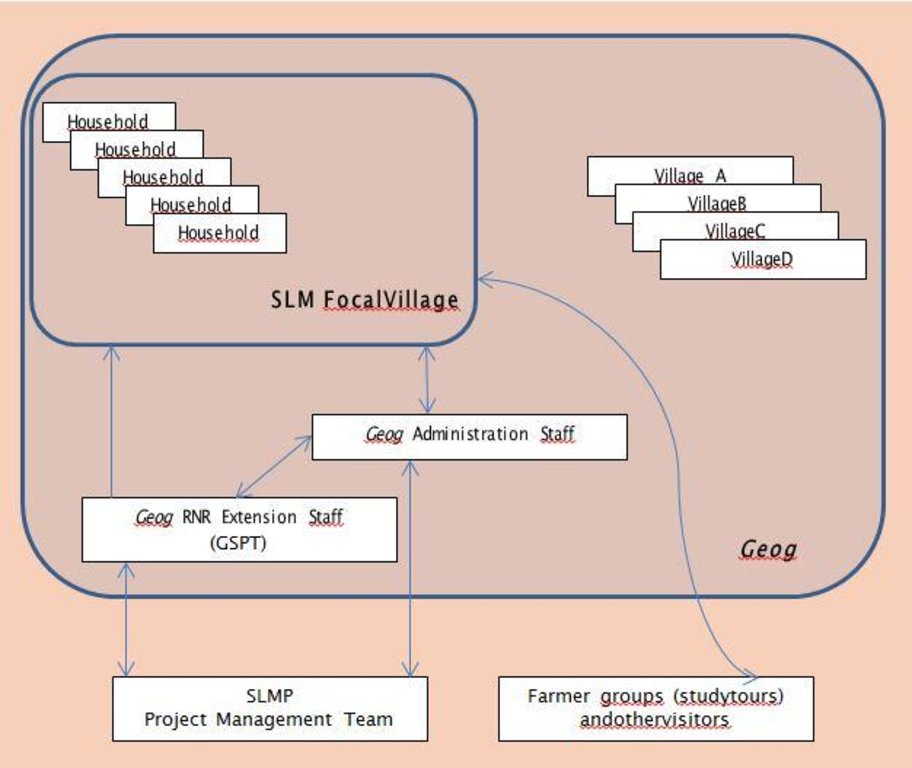SLM Focal Village [Bhutan]
- Creation:
- Update:
- Compiler: Karma Dorji
- Editor: –
- Reviewer: Fabian Ottiger
approaches_2490 - Bhutan
View sections
Expand all Collapse all1. General information
1.2 Contact details of resource persons and institutions involved in the assessment and documentation of the Approach
Name of the institution(s) which facilitated the documentation/ evaluation of the Approach (if relevant)
MoA (MoA) - BhutanName of the institution(s) which facilitated the documentation/ evaluation of the Approach (if relevant)
National Soil Services Centre (National Soil Services Centre) - Bhutan1.3 Conditions regarding the use of data documented through WOCAT
When were the data compiled (in the field)?
20/03/2011
The compiler and key resource person(s) accept the conditions regarding the use of data documented through WOCAT:
Ja
1.4 Reference(s) to Questionnaire(s) on SLM Technologies
2. Description of the SLM Approach
2.1 Short description of the Approach
Focused support to a single village community to promote the widespread integrated implementation of SLM interventions.
2.2 Detailed description of the Approach
Detailed description of the Approach:
Aims / objectives: A SLM Focal Village is an approach to focus support to a particular village where a whole range of integrated SLM interventions is showcased in order to create visual impact and to serve as a demonstration site. The concept of a SLM Focal Village was developed in order to tackle the concern of dilution of impact caused by inclusion of all the villages and the households that are geographically very scattered and dispersed. Focal villages are selected at geog (block) level based on their accessibility, visibility for visitors and passers-by, severity of land degradation issues and interest shown by the village community.
Methods: Participatory SLM Action Planning is used to identify land-based problems, their causes and to discuss, select and prioritize specific targeted SLM interventions into a chiog (village) SLM action plan. Additional support is given to the village community to convert larger complexes of clustered land to more sustainable use with locally suited SLM practices. Popular interventions are stone bunding, grass hedgerows, bench terracing, bamboo and tree plantation and fodder development. The for-mation of labour-sharing groups is promoted in the SLM Focal Villages to ease high labour requirement for some SLM activities.
Stages of implementation: Where possible, integrated approaches are adopted, linking increasing vegetative cover of degraded or vulnerable areas with fodder development in marginal slope segments. FYM shed construction is combined with breed improvement and transition to stall feeding, providing manure for cropland. The SLM Focal Villages are used as demonstration sites and interested farmer groups on study tours and other visitors can get a quick impression of a variety of SLM activities showcased in a limited geographical area.
Role of stakeholders: The SLM Focal Villages are used as demonstration sites and interested farmer groups on study tours and other visitors can get a quick impression of a variety of SLM activities showcased in a limited geographical area.
Other important information: SLM Focal Villages require more guidance and monitoring by local extension staff and relatively higher budgets as the areas of land converted to SLM practices are often larger and thus related expenses for seeds, seedlings and other incentives like tools. In some focal villages additional labour-saving machinery is supplied, for example maize flour mill, oil expeller, rice huller, cornflake machine, etc. as an incentive to the community for taking up SLM interventions on comparatively larger scale..
2.3 Photos of the Approach
2.5 Country/ region/ locations where the Approach has been applied
Country:
Bhutan
Region/ State/ Province:
Chhukha Dzongkhag
Further specification of location:
Phuntsholing geog, Serina chiog
Map
×2.6 Dates of initiation and termination of the Approach
Indicate year of initiation:
2009
Year of termination (if Approach is no longer applied):
2012
2.7 Type of Approach
- project/ programme based
2.8 Main aims/ objectives of the Approach
The Approach focused mainly on SLM with other activities (Advocay of implementation of various SLM techniques through focus village (chiog) approach)
- Creating a visible and tangible impact at chiog level through widespread implementation of SLM technologies
- Convert present fallow land and former slash-and-burn practice areas to more sustainable cropland with an improved fodder base
- Improve community sense and enhance sustainability of SLM approaches through group support
The SLM Approach addressed the following problems: - Inclusion of all households at village level in a large and geographically dispersed geog leads to dilution of (visual) impact and benefits.
- Targeting individual households makes it more difficult to create a focused demonstration area to showcase SLM interventions at village level
2.9 Conditions enabling or hindering implementation of the Technology/ Technologies applied under the Approach
institutional setting
- hindering
Transition of focus from individual household approach to labour-sharing approach, uniting lager groups of community members
Treatment through the SLM Approach: Group support, targeted training and guidance/monitoring
legal framework (land tenure, land and water use rights)
- enabling
The existing land ownership, land use rights / water rights greatly helped the approach implementation: Individual titled land tenure greatly help implementation of SLM activities as the land users have great commitment and feeling of ownership, getting direct benefits and leading in decision-making process.
workload, availability of manpower
- hindering
Larger areas to be treated with SLM interventions requires substantial work load of all households
Treatment through the SLM Approach: Labour-sharing groups to ease labour constraint and promote/enhance community bonding/sense
other
- hindering
Lack of direct tangible impact of long-term SLM interventions
Treatment through the SLM Approach: Combining long-term SLM activities with short-term inputs and incentives and additional capacity building / awareness raising
3. Participation and roles of stakeholders involved
3.1 Stakeholders involved in the Approach and their roles
- local land users/ local communities
Serina chiog community
Households from vulnerable groups (lower “well-being class” after chiog “well-being ranking”) are involved as much as possible in SLM interventions.
- SLM specialists/ agricultural advisers
- local government
Dzongkhag, geog and chiog administration together with the RNR extension staff and GSPs
- national government (planners, decision-makers)
RGoB, MoAF, DoA, NSSC, SLMP
- international organization
If several stakeholders were involved, indicate lead agency:
developed as result of internal review of project progress and impact
3.2 Involvement of local land users/ local communities in the different phases of the Approach
| Involvement of local land users/ local communities | Specify who was involved and describe activities | |
|---|---|---|
| initiation/ motivation | interactive | Initial meetings to sensitize farmers and to create awareness of SLM issues |
| planning | interactive | Participatory SLM action planning at chiog level; annual planning cycle, repeated for 3 years |
| implementation | interactive | Based on the chiog SLM action plan SLM interventions are implemented with input support and incentives; guidance and capacity building by municipality extension staff and geog SLM planners |
| monitoring/ evaluation | interactive | Participatory Monitoring & Evaluation meetings carried out by geogSLM planning team (GSPT) |
| Research | none |
3.3 Flow chart (if available)
Description:
SLM focal village and its linkage with support providers
Author:
Hans van Noord (Schoutenkamp 43 Heteren The Netherlands)
3.4 Decision-making on the selection of SLM Technology/ Technologies
Specify who decided on the selection of the Technology/ Technologies to be implemented:
- mainly land users, supported by SLM specialists
Explain:
the annual participatory SLM Action Planning is key approach used to identify and prioritize SLM technologies for implementation at village level.
Decisions on the method of implementing the SLM Technology were made by mainly by SLM specialists with consultation of land users. based on the SLM Action plan for the village and amended, if necessary, by the findings of M&E meetings
4. Technical support, capacity building, and knowledge management
4.1 Capacity building/ training
Was training provided to land users/ other stakeholders?
Ja
Specify who was trained:
- land users
If relevant, specify gender, age, status, ethnicity, etc.
Whole community involved with SLM: inclusive approach to all 44 households
Form of training:
- farmer-to-farmer
- demonstration areas
- public meetings
Subjects covered:
A series of awareness raising activities related to identification of local land-based problems, its causes and possible SLM interventions through an annual SLM action planning and following implementation. This is combined with specific technical trainings focused on the SLM activities prioritized in the village SLM action plan.
4.2 Advisory service
Do land users have access to an advisory service?
Ja
Specify whether advisory service is provided:
- on land users' fields
Describe/ comments:
Name of method used for advisory service: Field visits and meetings; Key elements: technical guidance, awareness raising and group formation support
Advisory service is inadequate to ensure the continuation of land conservation activities
4.3 Institution strengthening (organizational development)
Have institutions been established or strengthened through the Approach?
- yes, moderately
Specify the level(s) at which institutions have been strengthened or established:
- local
Specify type of support:
- financial
- capacity building/ training
- equipment
Give further details:
Yes, SLM focal village development is a direct form of local institution support.
4.4 Monitoring and evaluation
Is monitoring and evaluation part of the Approach?
Ja
Comments:
bio-physical aspects were ad hoc monitored by project staff, land users through observations; indicators: terrace area increase and area treated with stone bunds
bio-physical aspects were ad hoc monitored by project staff, land users through measurements; indicators: terrace area increase and area treated with stone bunds
technical aspects were regular monitored by project staff, land users through observations; indicators: Regular observations by project staff with land users of specific SLM interventions: progress, problems, areas for improvement
socio-cultural aspects were regular monitored by project staff, land users through observations; indicators: Regular observations on community / focal village approach through participatory M&E meetings; community sense, conflicts etc.
economic / production aspects were regular monitored by project staff, land users through measurements; indicators: Regular measurements by project staff and land users: crop yields, income, fodder and animal production
area treated aspects were regular monitored by project staff, land users through measurements; indicators: Regular measurements by project staff and land users: area of SLM interventions (hedgerows, stone bunds, bench terraces, # of check dams tec.)
no. of land users involved aspects were regular monitored by project staff, land users through measurements; indicators: Regular measurements by project staff and land users: number of households participating in each specific training and event (male/female)
management of Approach aspects were regular monitored by project staff, land users through observations; indicators: Regular observations by project staff and land users during participatory M&E meetings; ad hoc meetings with project management staff
There were few changes in the Approach as a result of monitoring and evaluation: Adjustment of technical interventions due to farmer feedback during participatory M&E meetings; review of annual SLM action plan leads to readjusted action plans based on evaluation with community on progress and issues.
There were few changes in the Technology as a result of monitoring and evaluation: Adjustment of technical interventions due to farmer feedback during participatory M&E meetings; review of annual SLM action plan leads to readjusted action plans based on evaluation with community on progress and issues.
5. Financing and external material support
5.1 Annual budget for the SLM component of the Approach
If precise annual budget is not known, indicate range:
- 10,000-100,000
Comments (e.g. main sources of funding/ major donors):
Approach costs were met by the following donors: international (World Bank GEF): 60.0%; government (RGoB): 20.0%; local community / land user(s): 20.0%
5.2 Financial/ material support provided to land users
Did land users receive financial/ material support for implementing the Technology/ Technologies?
Ja
5.3 Subsidies for specific inputs (including labour)
- equipment
| Specify which inputs were subsidised | To which extent | Specify subsidies |
|---|---|---|
| maize floor mill, green net sheds, water drums | partly financed | |
- agricultural
| Specify which inputs were subsidised | To which extent | Specify subsidies |
|---|---|---|
| seeds | fully financed | maize, paddy, vegetables |
- construction
| Specify which inputs were subsidised | To which extent | Specify subsidies |
|---|---|---|
| CGI sjeets, water drums and houses | fully financed | |
- other
| Other (specify) | To which extent | Specify subsidies |
|---|---|---|
| incentive payment | partly financed | per unit area of hedge row and stone bunding |
If labour by land users was a substantial input, was it:
- voluntary
Comments:
Labour is mainly voluntary contribution by household, but partly compensated with cash and other material support for the more labour-intensive interventions such as stone bunding and hedgerow establishment; labour-saving groups also supported with tool sets
Tool sets partly financed; seeds and seedlings mostly fully financed; CGI sheets, green net and drums for FYM sheds, green net sheds and water collection drums fully financed; some labour-saving machinery fully financed such as maize flour mill as community incentive.
5.4 Credit
Was credit provided under the Approach for SLM activities?
Nee
6. Impact analysis and concluding statements
6.1 Impacts of the Approach
Did the Approach help land users to implement and maintain SLM Technologies?
- No
- Yes, little
- Yes, moderately
- Yes, greatly
Increased area under SLM treatment with improved fodder availability and formation of SLM related groups (labour-saving group etc.); former slash-and-burn practice area now converted into more sustainable land use; water sources protected and degraded areas afforested.
Did the Approach improve issues of land tenure/ user rights that hindered implementation of SLM Technologies?
- No
- Yes, little
- Yes, moderately
- Yes, greatly
Absentee land owners can complicate a full coverage of SLM interventions. The problem is unlikely to be overcome in the near future. Land ownership is a private matter, which is difficult to change land use without permission of abent land owner
Did other land users / projects adopt the Approach?
- No
- Yes, little
- Yes, moderately
- Yes, greatly
Did the Approach lead to improved livelihoods / human well-being?
- No
- Yes, little
- Yes, moderately
- Yes, greatly
In terms of increased yield, improved fodder availability and quality and increased production area; enhanced community bonding through group activities and related easing of labour constraints (labour-saving groups).
Did the Approach help to alleviate poverty?
- No
- Yes, little
- Yes, moderately
- Yes, greatly
Through inclusion in labour-sharing groups labour constraint of vulnerable households addressed. Focus of hands-on training on land of most vulnerable households to give them first benefit and ensure inclusion.
6.2 Main motivation of land users to implement SLM
- increased production
Small immediate increase, but good increase in long-term
- increased profit(ability), improved cost-benefit-ratio
- reduced workload
labour-sharing groups: Reduced workload through improved land (with hedgerows, stone b
- payments/ subsidies
incentives and inputs
- rules and regulations (fines)/ enforcement
enforcement through GSPT/community
- environmental consciousness
environmental awareness
- well-being and livelihoods improvement
wish to improve food self-sufficiency and increase of continuous cropping area
6.3 Sustainability of Approach activities
Can the land users sustain what has been implemented through the Approach (without external support)?
- yes
If yes, describe how:
Village communities express commitment to continue focal village approach, but it remains to be seen if they actually are able to continue with various SLM activities without support post-project. The communities are intending to continue to convert ex slash-and-burn area to annual cropland, making use of labour-sharing group. This old traditional system is rejuvenated and therefore is more likely to be sustainable post-project.
6.4 Strengths/ advantages of the Approach
| Strengths/ advantages/ opportunities in the land user’s view |
|---|
|
reduced dependency on forest and tseri (How to sustain/ enhance this strength: maintenance of new annual crop land ) |
| more annual cropland through SLM interventions (How to sustain/ enhance this strength: maintenance of new annual crop land) |
|
better workability of developed cropland (stone bunding / hedgerows etc.) (How to sustain/ enhance this strength: maintenance of new annual crop land) |
| short-term inputs and subsidies enable the poorer households to take up log-term SLM interventions (How to sustain/ enhance this strength: targeted support to vulnerable households to maintain an inclusive approach) |
| Strengths/ advantages/ opportunities in the compiler’s or other key resource person’s view |
|---|
|
Holistic integrated village development enabling to showcase a variety of SLM interventions (How to sustain/ enhance this strength: Regular technical guidance and targeted capacity building efforts ) |
| Enables to convert larger areas of previous fallow land, or previously under slash-and-burn practice, to more sustainable cropland and reduces dependency on forest and slash-and-burn (How to sustain/ enhance this strength: Regular technical guidance and targeted capacity building efforts, combined with input support and guidance of labour-saving groups) |
| Pressure on communities to change land-use through governmental rule to stop slash-and-burn practice makes them very interested in adopting SLM (How to sustain/ enhance this strength: Regular technical guidance and targeted capacity building efforts, combined with short-term incentives) |
| Group formation process enables labour-sharing approach, which is very well appreciated (How to sustain/ enhance this strength: Regular technical guidance and targeted capacity building efforts) |
6.5 Weaknesses/ disadvantages of the Approach and ways of overcoming them
| Weaknesses/ disadvantages/ risks in the land user’s view | How can they be overcome? |
|---|---|
| Increase of work load combined with demand for labour of other developmental activities (rural water supply, road construction etc.). Therefore 'underperformance' against set targets | Better seasonal planning, try to avoid busy agricultural season. |
| Weaknesses/ disadvantages/ risks in the compiler’s or other key resource person’s view | How can they be overcome? |
|---|---|
| Risk of dependency on incentives/inputs: spoon-feeding syndrome |
Continued support to community and labour-saving groups to support land conversion efforts |
|
Focus and concentration of efforts to one community might cause dissatisfaction among neighbouring villages |
Continue SLM support to other villages as planned; communicate reasons of selection clearly: transparency at municipality level. |
| Requires considerable input of labour by community, but clashes with other requirement of developmental activities such as drinking water supply, irrigation channel construction, electrification and farm road construction | Labour-sharing group to ease labour constraint |
7. References and links
7.1 Methods/ sources of information
- field visits, field surveys
- interviews with land users
Links and modules
Expand all Collapse allLinks
No links
Modules
No modules


